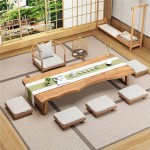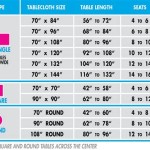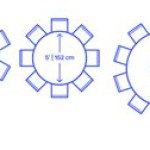78 Inch Table: Seating Capacity Considerations
The seating capacity of a 78-inch table is a common inquiry for individuals planning dining spaces, conference rooms, or event layouts. Accurately determining how many people can comfortably be seated around a table of this size is crucial for ensuring a positive and functional experience for all involved. Several factors influence the maximum seating, and it’s important to consider these variables to make informed decisions.
Calculating seating capacity isn't a precise science, as individual needs and preferences vary. However, by understanding the general guidelines and available space per person, one can arrive at a reasonably accurate estimate. This estimation process involves accounting for comfortable elbow room, chair size, and the overall layout of the surrounding area.
Understanding Standard Seating Guidelines
General recommendations suggest that each person at a dining table requires approximately 24 inches of linear space. This allowance provides sufficient room for individuals to eat comfortably without bumping elbows. It is important to note that this is a minimum recommendation, and some individuals may prefer more space.
To calculate the approximate number of people that can be seated around a 78-inch table, one needs to consider the table's shape. For a rectangular table, the length is the primary factor. For a round table, the circumference dictates the seating capacity. For other shapes, such as oval or square, the calculation becomes more complex and may require considering the perimeter.
For a rectangular 78-inch table, focusing on the length will provide the relevant measurement. Dividing the length by the recommended 24 inches per person yields an estimated number of seats along that side of the table. One should then consider the width of the table to determine seating on the opposite side or at the table ends.
It's also essential to factor in the chair size. Bulky chairs will require more space, potentially reducing the number of individuals that can be seated comfortably. Carefully consider the chairs' dimensions and leave adequate room for individuals to push their chairs back from the table without hitting adjacent furniture or individuals.
Impact of Table Shape on Seating Capacity
The shape of a 78-inch table significantly influences its seating capacity. A rectangular table offers a different seating configuration compared to a round or oval table of the same length. Each shape presents unique considerations for maximizing space and ensuring comfortable seating.
A rectangular 78-inch table is straightforward to calculate. If we assume the 78 inches represents the length, and the width is relatively standard (e.g., 36-42 inches), one can typically seat three people comfortably on each long side. Seating at the ends depends on the table's design and width. If the width is adequate, one person could be seated at each end, bringing the total to eight. However, if the width is narrower, seating at the ends might be less comfortable or not feasible.
A round table with a diameter of 78 inches presents a different scenario. The circumference of the table needs to be calculated (Circumference = πd, where d is the diameter). Thus, the circumference is approximately 3.14 x 78 = 244.92 inches. Dividing the circumference by the standard 24 inches per person suggests that approximately 10 people can be seated. However, this is a theoretical maximum. Depending on the base of the table and chair size, seating 8-9 people comfortably is a more realistic estimate.
An oval table offers a hybrid situation between rectangular and round. The seating capacity will depend on the specific dimensions of the oval. An elongated oval will lean more towards the rectangular calculation, while a more circular oval will be closer to the round table calculation. Accurate calculation requires measuring the perimeter of the oval.
Square tables with sides of 78 inches are less common for dining due to their large size. However, if such a table exists, it can comfortably seat three people on each side, resulting in a total of 12 possible seats. This configuration may feel crowded, and depending on the application, leaving some sides open may enhance comfort.
Factors Influencing Comfortable Seating
Beyond simple calculations, several practical considerations affect the actual comfortable seating capacity of a 78-inch table. These factors include chair style, room size, accessibility, and the intended use of the table.
Chair style plays a crucial role. Armchairs, for example, require more lateral space than armless chairs. Opting for slimmer, armless chairs can maximize the number of people that can be seated comfortably. Additionally, chair depth affects how much legroom is available under the table. Chairs that extend farther underneath the table may allow for a more compact seating arrangement. Evaluating chair size and design is a key step in determining optimal seating capacity.
Room size is another significant consideration. Even if a table can theoretically accommodate a certain number of people, the surrounding space must allow for comfortable movement. People need room to pull out their chairs, walk around the table, and generally navigate the area. Cramped conditions can significantly diminish the overall experience, regardless of the table's size. Consider the overall room dimensions and other furniture when determining seating capacity.
Accessibility is especially important in public spaces or when accommodating individuals with mobility limitations. Adequate space must be available for individuals using wheelchairs or other mobility aids. This may require reducing the total number of seats to provide sufficient maneuvering room around the table. Ensuring accessibility is a crucial aspect of thoughtful space planning.
Finally, the intended use of the table affects seating needs. A conference table used for meetings may require more space per person compared to a dining table used for casual meals. Conference participants often need room to spread out documents, laptops, or other materials. Understanding the purpose of the table allows for a tailored approach to seating capacity determination.
Ultimately, determining the ideal seating capacity for a 78-inch table involves a combination of mathematical calculations, practical considerations, and an understanding of the intended use of the space. By carefully evaluating these factors, one can create a functional and comfortable environment that meets the needs of all users.

Polibi 78 In Walnut Retro Style Wood Top Rectangular Dining Table Seats Up To 8 Rs 78rswt Wu The Home Depot

Saarinen Dining Table Extra White Marble Hive

Table Sizes How Many People At A Assigned Seating Diagram Tables Dining Custom Wedding Floor Plan

Rectangular Dining Table 78 Inch Long Kitchen For 6 8 Peoplerustic Brown In 2024 Rectangle

9pc Oval 60 78 Inch Table With 18 In Leaf 8 Vertical Slatted Chairs 1 Kroger

Beara 42 In Natural Brown Wood Top Double Pedestal Dining Table With Extendable Leaf And Trestle Base Seats 6 Bm283849 The Home Depot

East West Furniture Dodu7 Mah Lc 7pc Rectangular 60 78 Inch Dining Room Table With 18 In Erfly Leaf And 6 Faux Leather Seat Chairs Com

5pc Oval 60 78 Inch Table With 18 In Leaf And 4 Double X Back Chairs 1 Qfc

East West Furniture Dodu7 Mah Lc 7pc Rectangular 60 78 Inch Dining Room Table With 18 In Erfly Leaf And 6 Faux Leather Seat Chairs Com








